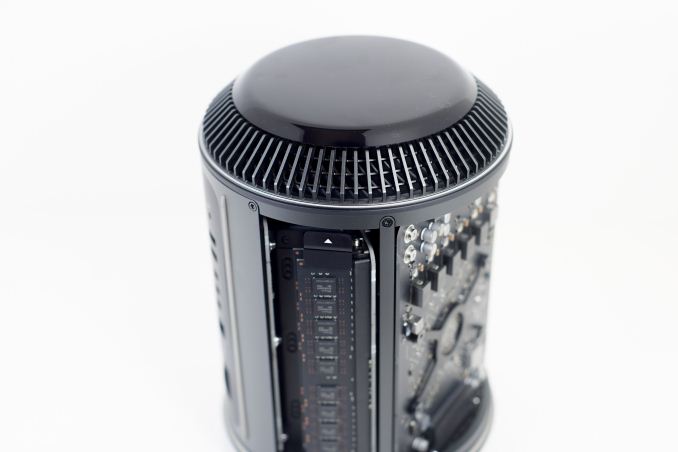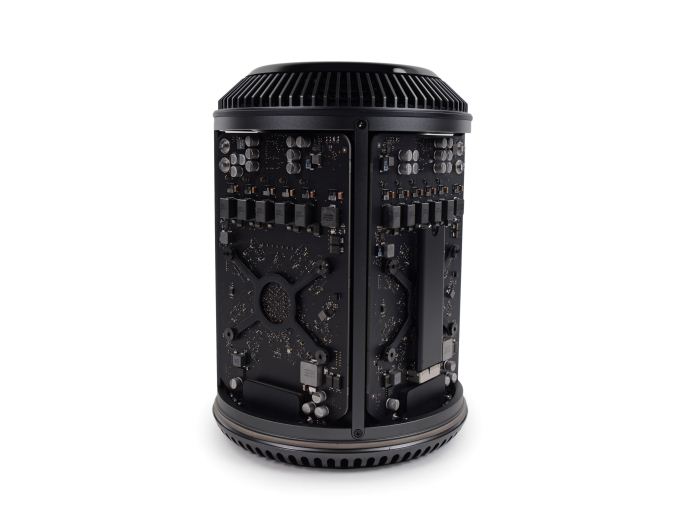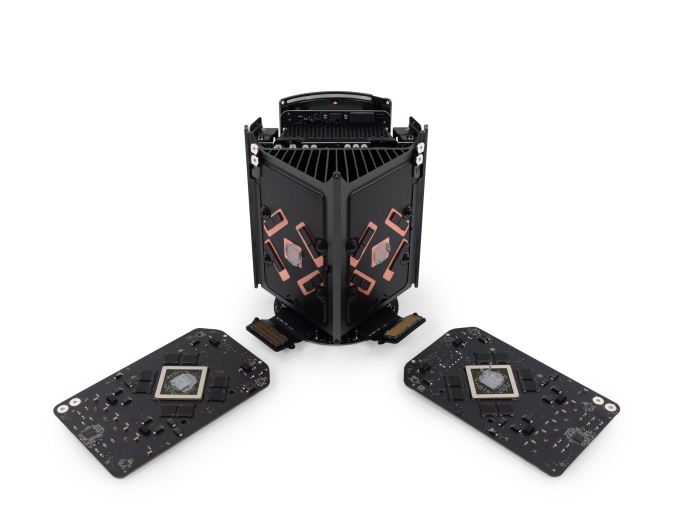Apple to Redesign Mac Pro, Comments That GPU Cooling Was A Roadblock
by Ryan Smith on April 4, 2017 10:20 AM EST
In what’s turning out to be an oddly GPU-centric week for Apple, this morning the company has revealed that they will finally be giving the long-neglected Mac Pro a major update in the 2018+ timeframe. Apple’s pro users have been increasingly unhappy by the lack of updates to the company’s flagship desktop computer, and once released, this update would be its first in what will be over 4 years.
Getting to the heart of matters, Apple invited a small contingent of press – including John Gruber and TechCrunch’s Matthew Panzarino – out to one of their labs to discuss the future of the Mac Pro and pro users in general. The message out of Apple is an odd one: they acknowledge that they erred in both the design and handling of the Mac Pro (as much as Apple can make such an acknowledgement, at least), and that they will do better for the next Mac Pro. However that Mac Pro won’t be ready until 2018 or later, and in the meantime Apple still needs to assuage their pro users, to prove to them that they are still committed to the Mac desktop and still committed to professional use cases.
Both of these articles are very well written, and rather than regurgitate them, I’d encourage you to read them. It’s extremely rare to see Apple talk about their future plans – even if it’s a bit vague at times – so this underscores the seriousness of Apple’s situation. As John Gruber puts it, Apple has opted to “bite the bullet and tell the world what your plans are, even though it’s your decades-long tradition — a fundamental part of the company’s culture — to let actual shipping products, not promises of future products, tell your story.”
However neither story spends too much time on what I feel is the core technical issue, Apple’s GPU options, so I’d like to spill a bit of ink on the subject, if only to provide some context to Apple’s decisions.
Analysis: GPUs Find Their Sweet Spot at 250 Watts
From a GPU perspective, the Mac Pro has been an oddball device from day-one. When Apple launched it, they turned to long-time partner AMD to provide the GPUs for the machine. What AMD provided them with was their Graphics Core Next (GCN) 1.0 family of GPUs: Pitcairn and Tahiti. These chips were the basis of AMD’s Radeon HD 7800 and HD 7900 series cards launched in early 2012. And by the time the Mac Pro launched in late 2013, they were already somewhat outdated, with AMD’s newer Hawaii GPU (based on the revised GCN 1.1 architecture) having taken the lead a few months earlier.
Ultimately Apple got pinched by timing: they would need to have chips well in advance for R&D and production stockpiling, and that’s a problem for high-end GPU launches. These products just have slow ramp-ups.
Complicating matters is the fact that the Mac Pro is a complicated device. Apple favored space efficiency and low-noise over standard form-factors, so instead of using PC-standard PCIe video cards for the Mac Pro, they needed to design their own cards. And while the Mac Pro is modular to a degree, this ultimately meant that Apple would need to design a new such card for each generation of GPUs. This isn’t a daunting task, but it limits their flexibility in a way they weren’t limited with the previous tower-style Mac Pros.

Mac Pro Assembled w/GPU Cards (Image Courtesy iFixit)
The previous two items we’ve known to be issues since the launch of the Mac Pro, and have commonly been cited as potential issues holding back a significant GPU update all of these years. However, as it turns out, this is only half of the story. The rest of the story – the consequences of Apple’s decision to go with dual GPUs and using a shared heatsink via the thermal core – has only finally come together with Apple’s latest revelation.
At a high-level, Apple opted to go with a pair of GPUs in order to chase a rather specific use case: using one GPU to drive the display, and using the second GPU as a co-processor. All things considered this wasn’t (and still isn’t) a bad strategy, but the number of applications that can use such a setup are limited. Graphical tasks are hit & miss in their ability to make good use of a second GPU, and GPU-compute tasks still aren’t quite as prevalent as Apple would like.
The drawback to this strategy is that if you can’t use the second GPU, two GPUs aren’t as good as one more powerful GPU. So why didn’t Apple just offer a configuration with a single, higher power GPU? The answer turns out to be heat. Via TechCrunch:
I think we designed ourselves into a bit of a thermal corner, if you will. We designed a system that we thought with the kind of GPUs that at the time we thought we needed, and that we thought we could well serve with a two GPU architecture… that that was the thermal limit we needed, or the thermal capacity we needed. But workloads didn’t materialize to fit that as broadly as we hoped.
Being able to put larger single GPUs required a different system architecture and more thermal capacity than that system was designed to accommodate. And so it became fairly difficult to adjust.
The thermal core at the heart of the Mac Pro is designed to be able to cool a pair of moderately powerful GPUs – and let’s be clear here, at around 200 Watts each under full load, a pair of Tahitis adds up to a lot of heat – however it apparently wasn’t built to handle a single, more powerful GPU.
The GPUs that have come to define the high-end market like AMD’s Hawaii at Fiji GPUs, or NVIDIA’s GM200 and GP102 GPUs, all push 250W+ in their highest performance configurations. This, apparently, is more than Apple’s thermal core can handle. In terms of total wattage, just one of these GPUs would be less than a pair of Tahitis, but it would be 250W+ over a relatively small surface area as opposed to the roughly 400W over nearly twice the surface area.
| Video Card Average Power Consumption (Full Load, Approximate) | |||
| GPU | Power Consumption | ||
| AMD Tahiti (HD 7970) | 200W | ||
| AMD Hawaii (R9 290X) | 275W | ||
| AMD Fiji (R9 Fury X) | 275W | ||
| NVIDIA GM200 (GTX Titan X) | 250W | ||
It’s a strange day when Apple has backed themselves into a corner on GPU performance. The company has been one of the biggest advocates for more powerful GPUs, pushing the envelope on their SoCs, while pressuring partners like Intel to release Iris Pro-equipped (eDRAM-backed) CPUs. However what Apple didn’t see coming, it would seem, is that the GPU market would settle on 250W or so as the sweet spot for high-end GPUs.

Mac Pro Disassembled w/GPU Cards (Image Courtesy iFixit)
And to be clear here, GPU power consumption is somewhat arbitrary. AMD’s Fiji GPU was the heart of the 275W R9 Fury X video card, but it was also the heart of the 175W R9 Nano. There is clearly room to scale down to power levels more in-line with Apple’s ability, but they lose performance in the process. Without the ability to cool a 250W video card, it’s not possible to have GPU performance that will rival powerful PC workstations, which Apple is still very much in competition with.
Ultimately I think it’s fair to say that this was a painful lesson for Apple, but hopefully one they learn a very important lesson from. The lack of explicit modularity and user-upgradable parts in the Mac Pro has always been a point of concern for some customers, and this has ultimately made the current design the first and last of its kind. Apple is indicating that the next Mac Pro will be much more modular, which would be getting them back on the right track.
Source: Daring Fireball










84 Comments
View All Comments
name99 - Tuesday, April 4, 2017 - link
OR what the 2018 timeline means is that that is the year we see the ARM Macs launched, together with custom Apple GPU?All this theorizing about Apple incompetence/Apple's determination to screw over individual members of the AnandTech readership ignores various basic facts of business life, like "you don't know the future till it happens".
Apple has probably had a roadmap for a while now for moving to an ARM Mac. Who knows what the GPU part of that roadmap was, but maybe it assumed parts that AMD or nV promised but could not deliver? Or maybe it assumed IMG would deliver something that they then dropped? Point is, for all we know, there may well have been a fine plan in place for an update in, say, mid 2016 based on x86 and a CPU that AMD could not ship. Or a plan for ARM Macs this year plus an IMG GPU that IMG dropped six months ago.
A delay this long strikes me as not planned but the result of a pre-existing plan going horribly wrong. The consequences likely include
(a) perhaps a year's delay in shipping the ARM Macs
(b) Apple's concluding that they HAVE to do their own GPU because every partner company they work with is too scared to aim for the stretch targets that Apple has in mind, or too concerned with making a PoS GPU that can be crippled for the mass market, rather than something that's innately expensive but also no compromise.
In other words the sequence is likely something like
- early 2016 AMD and/or IMG tell Apple they can't deliver
- Apple starts negotiating with IMG for a purchase
- purchase attempt fails because IMG CEO has bloated unrealistic sense of how valuable his company is
- Apple goes off to continue down their own path
- IMG (unexpectedly to Apple) releases their anti-Apple "we will bury you in court" rant yesterday
- Apple reckons they have nothing to lose at this point by exposing some of these issues to the public, including the expected ship date.
I'm guessing this last step would not have happened if IMG's rant had not happened.
vladx - Tuesday, April 4, 2017 - link
I can guarantee you 100% there won't be any ARM Mac in the near future.qasdfdsaq - Tuesday, April 4, 2017 - link
I can guarantee you 100% Apple won't be releasing a GPU that outperforms AMD or NVidia's top chips anytime soon either.In fact I can also guarantee you 100% pretty much everything in name99's pro Apple rant is incorrect.
Maleorderbride - Tuesday, April 4, 2017 - link
I think the simplest explanation is that they are waiting for Skylake-EP/big Ryzen, plus whatever GPU option, plus development time.Would Apple love to move to their own CPUs? Sure, but they don't have a product that can outcompete 32 Intel cores (or AMD ones).
Meteor2 - Wednesday, April 5, 2017 - link
'I'm guessing this last step would not have happened if IMG's rant had not happened.' -- except 'this last step' happened last week.Topweasel - Tuesday, April 11, 2017 - link
I think the long delay had more to do with lack of sales in the first place. Custom parts like the card and the CPU needing their own board types and power envelopes cost money. Lots of money. Even for a company like Apple. You displace that with volume.My guess is workstation numbers have been going down for a while as mac purchases seem to have shifted even more to a hipster lifestyle choice than some perceived app or platform superiority. So in typical fashion Apple made the workstation into a lifestyle product. That probably had a near zero or even negative result on sales. So while it would be one thing develop the product in the first place with the hope of growing sales, if the volume doesn't look large enough to support the development of further Proprietary parts it would be stupid to forge ahead.
peterfares - Tuesday, April 4, 2017 - link
Looking at that core, I'm surprised that it's able to handle 2x200W GPUs but can't handle 1x250W GPU. It would seem like just re-arranging those fins to just be coming out of one of those sides would be enough if no second GPU was installed. Guess not though.BillBear - Tuesday, April 4, 2017 - link
Two widely spaced smaller thermal loads are not the same thing as one larger thermal load.The mistake Apple made was not simply ignoring the critics who went on and on about the cheese grater Mac Pro design being too long in the tooth in the first place.
name99 - Tuesday, April 4, 2017 - link
Just because Apple mention ONE problem doesn't mean that is THE problem that kept them going forward. Thermals is, I agree, a minor issue that could have been worked around. There's no rule that says that, even if you retain the same basic shape as the current Pro, you can't make it larger or whatever.The real issue is likely something like Apple wanted a substantially better GPU (better along some metric they'd rather keep secret --- more neuro-targeted? better HSA? support for larger higher bandwidth HBM?) and the partner they expected to deliver this did not do so.
qasdfdsaq - Tuesday, April 4, 2017 - link
The whole point of this article is to discuss the fact that it's THE problem, and I don't see anything else mentioned. Absolutely everything else you suggested has already been delivered by and to other partners in commercial GPUs today. Pascal. Polaris. Vega. All heavily neuro-targeted. Strong HSA. 32GB HBM(2). Hundreds of custom PCBs all over.